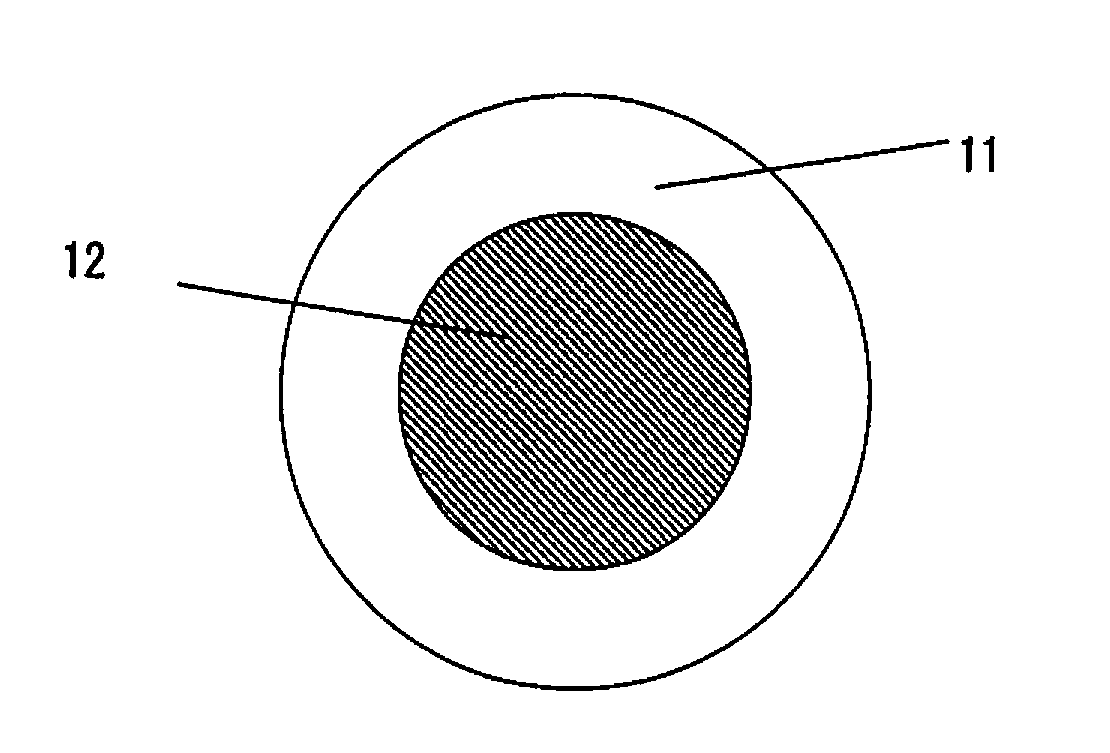Heat-expandable microspheres, process for producing the same, and application thereof
a technology of expansion and microspheres, which is applied in the field of expansion microspheres, can solve the problems of difficult dehydration (or filtration) of reaction mixtures, poor adhesion between resins and heat-expandable microspheres, and difficult to remove colloidal silica. achieve excellent heat-expansion performance, improve the properties of compositions containing, and high encapsulation efficiency
- Summary
- Abstract
- Description
- Claims
- Application Information
AI Technical Summary
Benefits of technology
Problems solved by technology
Method used
Image
Examples
example 1
[0229]An aqueous dispersion medium comprising 12 parts of fine-particle magnesium hydroxide was prepared by adding 45 parts of magnesium chloride hexahydrate and 1 part of an aqueous solution comprising 2 wt % of N-lauryl-N,N-bis ((POE(2)) aminoacetic acid betaine to 850 parts of deionized water, and gradually dropping 32 parts of an aqueous solution comprising 50 wt % of sodium hydroxide to control the pH of the aqueous medium in a range from 9 to 10.5. The amount of water contained in the aqueous dispersion medium was 891 parts, and the aqueous dispersion media in the following Examples and Comparative examples were prepared to contain 891 parts of water. The fine-particle magnesium hydroxide formed a colloid in the aqueous dispersion medium.
[0230]An oily mixture was prepared by mixing and dissolving 170 parts of acrylonitrile, 70 parts of methacrylonitrile, 1 part of ethylene glycol dimethacrylate, 1.5 parts of 2,2-azobisbutylonitrile and 60 parts of isopentane.
[0231]The aqueous ...
examples 2 to 11
[0235]In Examples 2 to 11, heat-expandable microspheres were produced by polymerization, pH decreasing and washing in the same manner as that in Example 1 except that the polymerization parameters including the variant and amount of the dispersion stabilizers and dispersion stabilizing auxiliaries were settled as shown in Table 1. The properties of the resultant heat-expandable microspheres were tested and the results are also shown in Table 1.
[0236]The heat-expandable microspheres after the pH decreasing (to pH of 4) contained 0% of ash and the heat-expandable microspheres after washing also contained 0% of ash.
TABLE 1Example1234567891011Oily mixtureMonomerAcrylonitrile (AN)170170170170170170170170170170170Methacrylonitrile (MAN)7070707070707070707070Cross-linking agentEthyleneglycol dimethacrylate11111111111Polymerization2,2′-azobisisobutylonitrile1.51.51.51.51.51.51.51.51.51.51.5initiatorBlowing agentIsopentane (iC5)6060606060606060606060Aqueous dispersionH2O891891891891891891891...
example a1
[0246]In a separable flask, 20 parts of the heat-expandable microspheres produced in Example 10 and 80 parts of calcium carbonate (Whiten SB Red, manufactured by Bihoku Funka Kogyo Co., Ltd.) were placed and heated with agitation to 150° C. in 5 minutes. Then the mixture was cooled down and screened with a 60-mesh sieve to obtain fine-particle-coated microballoons A having a mean particle size of 40 μm and a true specific gravity of 0.12.
[0247]A two-component polyurethane adhesive component (Bond UP Seal Gray, manufactured by Konishi Co., Ltd.) comprising a base component of isocyanate and a curing agent of polyol was prepared. To 80 parts of the curing agent, 4.3 parts of the fine-particle-coated microballoons A was added, and the mixture was agitated with a versatile mixer (5DM-r, manufactured by Shinagawa Machinery Works Co., Ltd) for 20 min. The resultant mixture was agitated and defoamed with a conditioning mixer (AR-360, manufactured by Thinky Corporation) to make an adhesive ...
PUM
| Property | Measurement | Unit |
|---|---|---|
| heat-expandable | aaaaa | aaaaa |
| amphoteric | aaaaa | aaaaa |
| pH | aaaaa | aaaaa |
Abstract
Description
Claims
Application Information
 Login to View More
Login to View More - R&D
- Intellectual Property
- Life Sciences
- Materials
- Tech Scout
- Unparalleled Data Quality
- Higher Quality Content
- 60% Fewer Hallucinations
Browse by: Latest US Patents, China's latest patents, Technical Efficacy Thesaurus, Application Domain, Technology Topic, Popular Technical Reports.
© 2025 PatSnap. All rights reserved.Legal|Privacy policy|Modern Slavery Act Transparency Statement|Sitemap|About US| Contact US: help@patsnap.com



